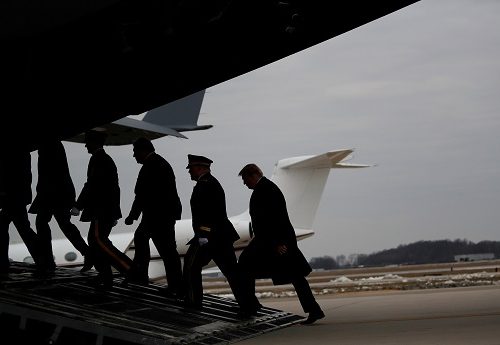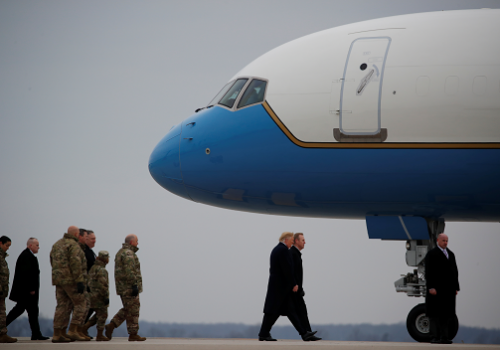After the Syria withdrawal, it’s time the US rethinks the use of proxy forces
Key Points
- Proxy warfare appears set to shape twenty-first century conflicts.
- The development of proxy warfare framework and set protocols with stabilizing measures is highly needed.
- Overestimating the cost-benefit of a proxy partner without realistic expectations can lead to disastrous ripple effects.
The failure in Syria
The foreign policy debacle in Syria, marked by US President Donald Trump’s speedy withdrawal of American troops, and a Turkish invasion in areas under control of Washington’s former ally the Syrian Democratic forces (SDF), is a humiliating end to the United States military intervention in Syria. Yet, the supposed American disentanglement from “forever wars” does not herald the end of ongoing proxy wars.
On the contrary, it is likely the use of a proxy, which is a non-state actor supported by a state in a given conflict, will continue to be normalized in indirect conflicts where great powers compete. What lessons can the US learn from the collapsing security architecture in northeastern Syria and how will it impact America’s future capability to leverage proxies? And how will it seek to compete with other great powers that better utilize proxy warfare, like Russia?
Past lessons
Since the Cold War, conditions conducive to overt interstate war have slowly eroded. Whether in the area of military technological advances or a reduction in the global military footprintstates such as Iran, Russia or the United States have made ample use of covert warfare by outsourcing military combat.
The United States has a long and not-so-glorious history with the use of proxies. The creation of the SDF and the harnessing of the Iraqi special forces Operation Inherent Resolve—managed by the Combined Joint Task Force, established by the US-led international coalition against the Islamic State (ISIS), and set up by the US Central Command to coordinate military efforts against ISIS—is a primary example of an established proxy.
Washington’s sporadic use of military proxies to achieve foreign policy and security interests is misguided at best, and ineffective at worst. The most notable US military sponsorship took place in Afghanistan, where it supported tribal factions and government forces, known as the Mujahideen, against the Soviet occupation during the 1980s. Ironically, a faction of this proxy group would later form the ranks of al-Qaeda that would attack the United States on 9/11.
Other not-so-illustrious Cold War examples also include American support for the Hmong tribesmen in Laos during 1963-71, and the Nicaraguan Contras during the 1980s. More recently, over the past four years the United States funded missions by the African Union Mission to contain and hamper the activity of the radical Shabab in Somalia and funded Arab tribes in Iraq during the 2007 Anbar Awakening to ultimately fend off al-Qaeda.
Russian assets
On the other hand, Russia has undoubtedly a longer and more successful experience with proxy warfare. During the Cold War, the Soviet Union made good use of proxies, such as Cuban forces during the civil war in Angola. Post-Soviet Russia, under the presidency of Boris Yeltsin also resorted to using volunteers to defend its foreign interests in its spheres of influence. Russia leveraged proxies in Syria, where it deployed Private Military Companies (PMCs) such as the Wagner group, or built more local formations such as the Fifth Corps.
PMCs have also been used by Russia in Africa, such as in the Central African Republic. Another successful venture has been to resort to Caucasian militant groups in post-Soviet areas, with the most well known example being the Ukraine’s Donets River basin where separatists have been able to capture part of Eastern Ukraine.
Moving forward
With the erosion of state power in the Middle East and North Africa proxy warfare appears set to shape twenty-first century conflicts. This is due to the breaking of security institutions in conjunction with the exacerbation of ethnic and religious rivalries, adding to issues of resource competition and the increasingly polyarchic nature of the international system. The regional power level of proliferation of weapons of mass destruction (WMDs) partnered with the US disengagement from the Middle East translates to other states as proxies being a cost-effective means for deescalation. Whereas, previous avenues for limiting conflict were based more on conventional or diplomatic solutions.
Contrary to Russia, it seems the United States has not adapted yet to this new reality or developed a blueprint for asymmetric engagement. America is increasingly focused on the threat of hybrid warfare post-9/11, while Russia inherited its reliance on proxies and irregular warfare from its Soviet past and appears to have incorporated it in a systemic manner to its military playbook used in Chechnya during 1994 and Georgia during 2008, and most recently in Syria since 2011.
Lessons not learned
The example of Syria shows the shortcomings of the US approach, which has been reactionary, haphazard, and ultimately counter-productive. The calculations by the United States in the past have been motivated by the short-term urgency of the fight against ISIS.
The Obama administration’s decision to drop its Syrian Train and Equip Program in 2015, and to grant the Kurdish People’s Protection Units (YPG) leadership of what would become known as the SDF, disregarded potential local and regional frictions with Arab communitiesand with its ally Turkey; which considered the rise of the SDF as a direct national threat issue. When pressured by Turkey, the Trump administration once again favored a short reactionary approach in the form of a swift exit strategy. Absent proper stabilization, this strategy triggered a return of regime forces to northeastern Syria and a resumption of ISIS activity. Both the Obama and Trump administrations implemented a disastrous policy, subsequently overestimating the cost-benefit of a proxy partner in Syria. Ultimately, it will hinder its two presumed goals: the defeat of ISIS and a containment of Iranian influence in the region.
The development of a proxy warfare protocol is very much needed in the current framework. Proxy relations will remain interest-based and transactional for Washington. Contrary to what pundits may say, the Syrian fiasco will not hinder its capability to increase military allies, as recent history with the Kurds has shown. Thus, future policies should be based on a cohesive strategy, both at government and defense levels, that includes a proper timeline as well as an exit and stabilization phase to be put in place for any successful military ally relationship. The issue of convenience should not supersede matters of the proxy’s legitimacy as seen with the harnessing of the PYG, which posed issues for an American ally, namely, Turkey, as well as the Arab ethnic groups where the proxy was deployed.
Transparent communication between the sponsor and the surrogate is needed to monitor human rights infringements in the short and long term in order to avoid another Syria failure. While proxy warfare should also remain an exceptionally morally permissible endeavor, its normalization requires that benchmarks are clear and a procedure is established. If not, the United States will be faced again with yet another foreign policy dilemma, with short-term policies demanding long-term strategic relations.
Mona Alami is a nonresident senior fellow with the Atlantic Council’s Middle East programs.
Related Content
Image: A convoy of U.S. vehicles is seen after withdrawing from northern Syria, on the outskirts of Dohuk, Iraq, October 21, 2019. REUTERS/Ari Jalal TPX IMAGES OF THE DAY


